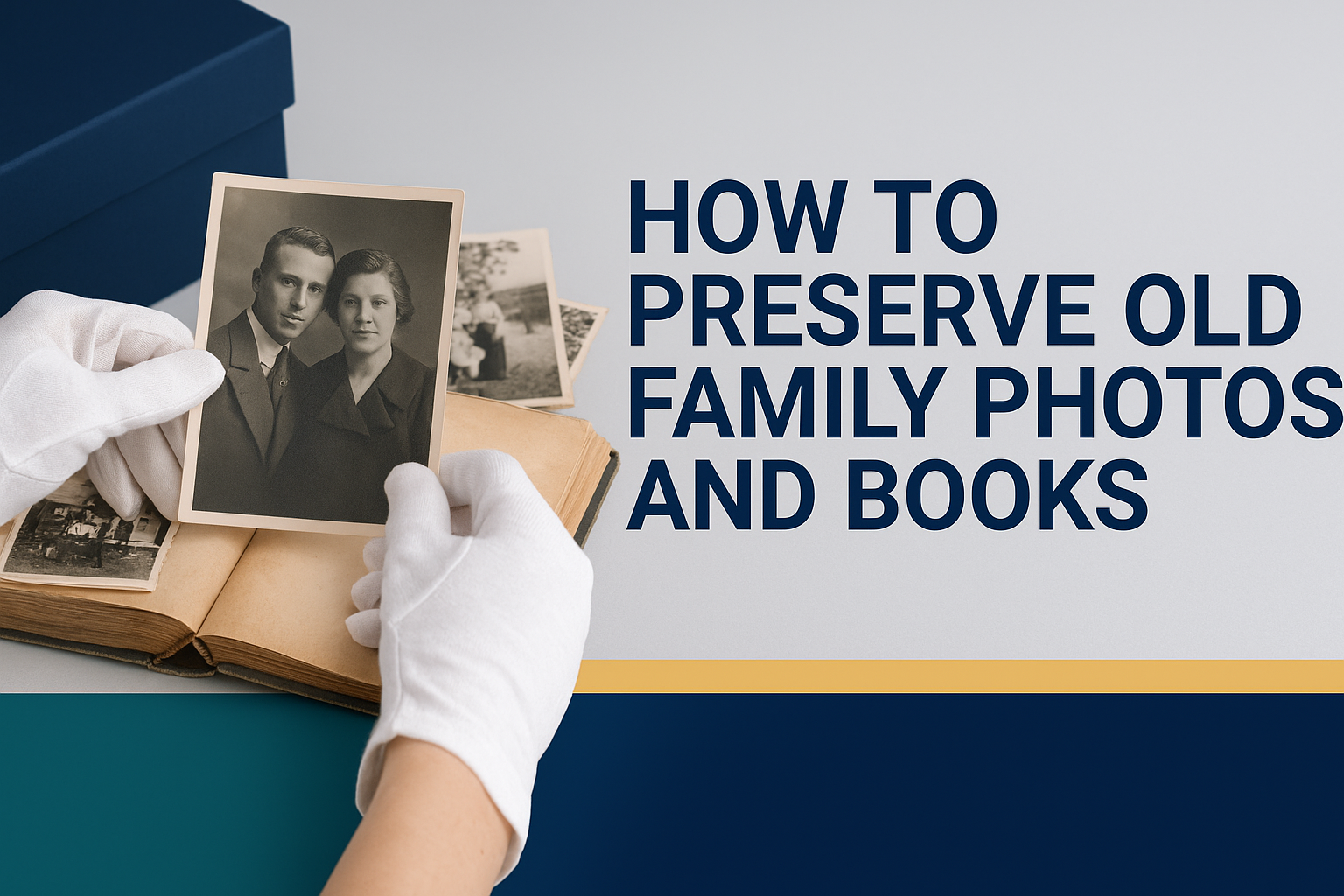How to Protect Your Old Family Memories
Beginner | July 22, 2025
✨ Read the article aloud on your own or repeat each paragraph after your tutor.
Creating the Right Home for Your Treasures
Why You Should Preserve Old Family Photos and Books
The Perfect Climate and Place
Do you have old family photos or cherished books that you want to keep safe for a long time? Learning how to preserve old family photos and books is easier than you might think. It’s really important to give them a good home! For photos, try to keep them in a cool, dry place, ideally around 65°F (18°C) or below, with humidity between 30-50%. If it’s too hot, they fade. Too much moisture means mold and bugs! For books, a consistent temperature of 62-72°F (18-21°C) and 40-50% humidity is best. Always avoid places like attics or basements, because the temperature and humidity change too much there, which can damage your items.
Light and Safe Storage
Light is another big enemy for your precious items. Direct sunlight, and even strong indoor lights, can make photos fade and books yellow. Always store your photos and books in dark places, or use special UV-filtering glass if you display them. When you put them away, use only acid-free materials like special boxes, folders, and sleeves. Never use sticky tapes, paper clips, or regular glue, as these will cause permanent damage over time. Books should mostly stand upright, but very large or heavy books are better stored flat to protect their bindings.
Modern Ways to Keep Memories Alive
The Power of Digitization
One of the best modern ways to protect your old photos and books is to digitize them. This means scanning them to create digital copies! It’s one of the smartest ways to preserve old family photos and books in today’s digital world. High-quality scans (like 600 or 1200 DPI for photos) make great backups. You can then store these digital files on your computer, a hard drive, or in cloud storage. This is super helpful because it means you don’t have to handle the original fragile items as often. Big groups like the Digital Public Library of America are also doing this for many historical items, making them available to everyone.
Careful Handling and Expert Help
When you do need to touch your old photos or books, always use clean, dry hands. For photos, it’s even better to wear clean gloves, like nitrile or cotton, to avoid leaving oily fingerprints. Try not to touch the actual picture part of a photo. If something valuable is damaged, don’t try to fix it yourself! It’s always best to ask a professional conservator. They know exactly how to repair delicate items without causing more harm. Regularly dusting your books and shelves also helps keep pests away and prevents damage.
Vocabulary
- Paramount (adjective): More important than anything else; supreme.
- Example: “Keeping a stable environment is paramount for preserving old photos.”
- Deterioration (noun): The process of becoming progressively worse.
- Example: “High temperatures accelerate the deterioration of photographs.”
- Susceptible (adjective): Likely or liable to be influenced or harmed by a particular thing.
- Example: “Books are susceptible to fading from direct sunlight.”
- Archival-safe (adjective): Materials specially made not to harm or degrade items stored in them over time, often acid-free.
- Example: “Always use archival-safe boxes and sleeves for your photos.”
- Embrittlement (noun): The process of becoming brittle or fragile.
- Example: “Extremely low humidity can cause embrittlement in paper.”
- Digitizing (verb): The process of converting information or images into digital form.
- Example: “Digitizing old family photos is a great way to create backups.”
- Accessible (adjective): Able to be reached or entered; easily used or understood.
- Example: “Digital copies make old family memories more accessible.”
- Conservators (noun): People who are trained to preserve and restore artifacts and works of art.
- Example: “If a valuable book is damaged, consult professional conservators.”
- Initiatives (noun): Important new plans or programs.
- Example: “Community initiatives are helping to digitize vast collections.”
- Fluctuations (noun): Irregular rising and falling in number or amount; variations.
- Example: “Temperature fluctuations can cause materials to expand and contract.”
Discussion Questions (About the Article)
- Why is it important to keep old photos and books in a cool, dry place?
- What kinds of materials should you avoid when storing old family items?
- How can digitizing your photos and books help preserve them?
- Why is it better to consult a professional if a valuable item is damaged, instead of trying to fix it yourself?
- What are two ways you can handle old photos and books carefully?
Discussion Questions (About the Topic)
- Do you have any old family photos or books that are special to you? Where do you keep them?
- What do you think is the biggest challenge in preserving old physical items?
- How has technology changed the way we think about preserving historical items?
- Do you believe physical books will always be important, even with so many digital options? Why or why not?
- If you digitized all your family photos, how might you share them with others?
Related Idiom
A trip down memory lane
- Meaning: An occasion when people remember happy events from the past.
- Example: “Looking through my grandmother’s old photo albums was a real trip down memory lane.”
📢 Want more tips like this? 👉 Sign up for the All About English Mastery Newsletter! Click here to join us!
Want to finally Master English but don’t have the time? Mastering English for Busy Professionals is the course for you! Check it out now!
Follow our YouTube Channel @All_About_English for more great insights and tips
This article was inspired by: July 15 2025 – NPR


